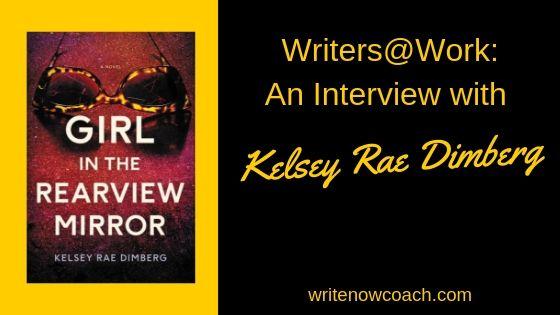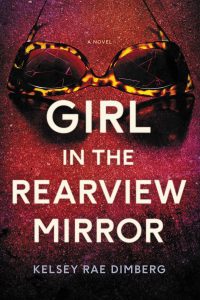Writers@Work: An Interview with Kelsey Rae Dimberg
June 18, 2019
Note From Rochelle
Dear Writers,
I’m on my way to Chicago for a writer’s conference. I’m looking forward to spending time with other people who write and learning about what’s new in the publishing world! I’ll let you know what I learn.
Today I’m delighted to welcome Kelsey Rae Dimberg to the blog to talk about her new novel, Girl in the Rearview Mirror. Dimberg will appear at Boswell Book Company on Thursday night at 7:00 PM. If you live in Milwaukee and love a good thriller—you won’t want to miss it!
Enjoy!
Rochelle

Writers@Work: An Interview with Kelsey Rae Dimberg
By Rochelle Melander
Tell us about your new book, Girl in the Rearview Mirror.
 Girl in the Rearview Mirror is part modern noir, part literary thriller, with a dash of political intrigue. At its center is the wealthy, powerful Martin family of Phoenix, Arizona. The patriarch is a longstanding US Senator; his son, Philip, is a real estate developer and former football hero whose wife, Marina, is the director of the Native American Arts museum. The story is narrated by the family’s nanny, Finn Hunt, a midwestern girl who is utterly enamored with the Martins and their glamorous lifestyle. When four-year-old Amabel tells Finn a woman is following her, Finn brushes it off: the Martins are wrapped up in the Senator’s contentious reelection campaign, and she thinks Amabel is vying for attention. When it turns out someone really is following her, Finn finds herself in over her head as the truth about who the Martins are—and the lengths to which they’ll go to remain in power—is slowly revealed.
Girl in the Rearview Mirror is part modern noir, part literary thriller, with a dash of political intrigue. At its center is the wealthy, powerful Martin family of Phoenix, Arizona. The patriarch is a longstanding US Senator; his son, Philip, is a real estate developer and former football hero whose wife, Marina, is the director of the Native American Arts museum. The story is narrated by the family’s nanny, Finn Hunt, a midwestern girl who is utterly enamored with the Martins and their glamorous lifestyle. When four-year-old Amabel tells Finn a woman is following her, Finn brushes it off: the Martins are wrapped up in the Senator’s contentious reelection campaign, and she thinks Amabel is vying for attention. When it turns out someone really is following her, Finn finds herself in over her head as the truth about who the Martins are—and the lengths to which they’ll go to remain in power—is slowly revealed.
I began the book after I moved away from Arizona, and I missed it. I wanted to portray the state as I remembered it: frigid air conditioning and glittering swimming pools, looping freeways and sprawling suburbs, glass-walled mansions and run-down ranches. Arizona felt like an ideal noir setting, the glaring sun a menacing inverse of shadowy streets.
What books or events inspired you to write this book?
Once I decided I wanted to write a noir (more on that below), I knew I wanted to write about a powerful family that appears perfect from the outside, yet is hiding dark secrets. I suppose this interest in the class theme came partly from current events, partly from my living in San Francisco and being moments away from both extreme wealth and poverty, and from the classic noir I was reading—Raymond Chandler, Ross MacDonald, and Sebastian Japrisot were three major influences.
The question became who might have access to a super wealthy family, yet also be an outsider. I didn’t want a private investigator for a narrator; I just wanted an ordinary woman. So my narrator became the family’s nanny. She has intimate access to their lives, their home, and yet she’s an outsider, and is definitely of a lower social class.
The other seed I started with was the idea of the little girl going to her nanny with a mystery, in the way that femme fatales go to private eyes at the start of many classic noirs. I had the idea that four-year-old Amabel Martin tells Finn that a woman is following her, and my early drafts were writing to understand who the woman was and what she wanted, and the family’s secrets and the overall plot developed from there.
What drew you to the mystery/thriller genre?
I came to the genre almost by accident. When I started writing seriously, in college and grad school, I wrote very traditional “literary” stories, with subdued emotions and sudden epiphanies. My dream was to write a novel, and I managed to write a full first draft of a coming-of-age story, featuring a moody male protagonist who mostly loafed around and had deep thoughts. It was a struggle to make any action happen, and I frankly dreaded working on it.
Around the same time, I was watching lots of classic film noir—Chinatown, Double Indemnity, Sunset Boulevard, Laura. Maybe I was escaping from the tamped-down stories of school and relishing the amplified emotion and drama of the genre. I loved the moodiness, the flashes of nastiness. I decided I’d write a noir novel, just for fun. That was about nine years ago, and I never looked back. For whatever reason, I found my voice in the crime/thriller/noir genre, and I had much more fun with every element of writing, from plot to character to setting. It all just clicked.
Many of our readers are trying to write books. What are your secrets for getting writing done?
After I received my MFA, I took a full-time job in Chicago, and I really struggled to write. I’d bring out my manuscript on Sunday afternoons and putter around, but I struggled to make real progress. I had this idea that a writing session was only worthwhile if I hit a high word count, and writing became tainted with a feeling of failure.
Finally, I made a rule: I had to write every day, but any amount of writing counted, whether I managed one sentence or 1,000 words. As long as I opened up the Word doc and did something, it counted. This one rule completely changed my writing life. I started writing every day, and once I was in the habit, it became easier to up my word count. Just as important, though, writing every day kept the story at the top of my mind, which made it easier to work through problems and stay in the voice, and I had more of those random epiphanies you get when you’re washing dishes or out walking the dog. I also learned not to be so precious about only writing when I’m inspired, or when I have a large block of free time, and now I use any time I have to write, whether it’s a full morning or a half-hour lunch break, and I write even if I’m not in the mood; inspiration is a luxury, not a necessity.
What are you working on now?
I’m working on a second novel. It’s a standalone, also a literary thriller, set in San Francisco.
What are you reading now?
I just finished Jo Walton’s Small Change trilogy, an alternative history set in an England that signed a peace treaty with Hitler instead of fighting the war, and is sliding toward fascism. The first novel is a classic murder mystery set in a country manor house, the second is a theater-centered thriller, and the third is a political thriller. The plots are interesting homages to classic genres, but what really kept me reading was the eeriness of the ease with which fascism, bigotry, and authoritarian law took hold over the country, largely because of public fear and indifference.
Other recent favorites include novels by the classic crime writer Margaret Millar, who was married to Ross MacDonald, especially A Stranger in My Grave. I also recently re-read Kate Atkinson’s Jackson Brodie series, as she’s got a new one coming out this June. I’m such a fan of all of her writing; her voice is so rich and there’s such a sense of play in her work even as it deals in tragedy and violence. Finally, I thoroughly enjoyed Lou Berney’s November Road, as well as The Long and Faraway Gone. Really excellent crime fiction.
 About the author. Kelsey Rae Dimberg received an MFA from the University of San Francisco and studied at Barrett Honors College of Arizona State University, where she was editor-in-chief of the literary magazine, Lux. Girl in the Rearview Mirror is her first novel. She lives in Milwaukee with her husband and dog.
About the author. Kelsey Rae Dimberg received an MFA from the University of San Francisco and studied at Barrett Honors College of Arizona State University, where she was editor-in-chief of the literary magazine, Lux. Girl in the Rearview Mirror is her first novel. She lives in Milwaukee with her husband and dog.








